| |
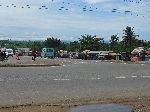 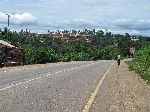 Commerce
and armies have been traveling through the corridor between Kumasi and the coast for centuries, but it has
only been since the 1990s that the road have been good enough for easy
access for the general public. Commerce
and armies have been traveling through the corridor between Kumasi and the coast for centuries, but it has
only been since the 1990s that the road have been good enough for easy
access for the general public.
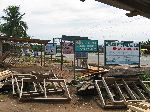 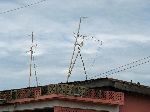 The
roads provide the opportunity for increased economic activity and affluence.
Increasing, along the road there are broad signs advertising business and events
(left) and television antenna sprout from roof tops in even isolated communities (right). The
roads provide the opportunity for increased economic activity and affluence.
Increasing, along the road there are broad signs advertising business and events
(left) and television antenna sprout from roof tops in even isolated communities (right).
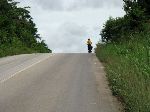
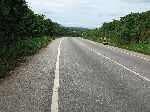
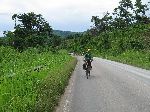
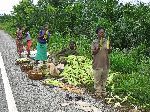 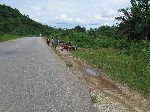 Additional
scenes from the road show very little vehicle traffic, a family sell their fresh
corn harvest or piles of fire wood and the occasional town peeking out of the Additional
scenes from the road show very little vehicle traffic, a family sell their fresh
corn harvest or piles of fire wood and the occasional town peeking out of the
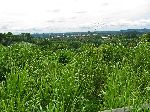 forest. So much didn't
get photographed: Towns generally had health clinics, schools, police post,
small forest. So much didn't
get photographed: Towns generally had health clinics, schools, police post,
small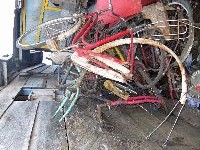 stores, market, bicycle repair service and various boutiques.
It is amazing the extent and quantity that used bicycles have penetrated into
the Ghanaian market structure. It seems like every bike shop has a bone yard of used
bicycles. When will some businessman come around to collect all of this
recyclable metal to cash in on
it? stores, market, bicycle repair service and various boutiques.
It is amazing the extent and quantity that used bicycles have penetrated into
the Ghanaian market structure. It seems like every bike shop has a bone yard of used
bicycles. When will some businessman come around to collect all of this
recyclable metal to cash in on
it?
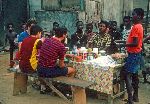 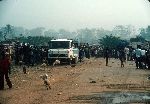 This
tends to be an area where restaurants don't exists. In the even dinner can
be purchased from roadside venders who sell rice, beans, vermicelli, meat, fish,
chicken and salad. We are always please when we can find a nice table with
eggs, bread, coffee and tea, at breakfast time. This
tends to be an area where restaurants don't exists. In the even dinner can
be purchased from roadside venders who sell rice, beans, vermicelli, meat, fish,
chicken and salad. We are always please when we can find a nice table with
eggs, bread, coffee and tea, at breakfast time.
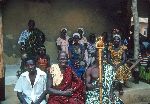 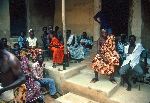 Ghana
still maintains a hierarchical structure of traditional chiefs at the town,
district and regional level, that serve functional roles in their community.
The symbol of power is the "stool" (below left), which is only occupied by the chief
(below center).
The court's linguist is identified by his staff (below right). Ghana
still maintains a hierarchical structure of traditional chiefs at the town,
district and regional level, that serve functional roles in their community.
The symbol of power is the "stool" (below left), which is only occupied by the chief
(below center).
The court's linguist is identified by his staff (below right).
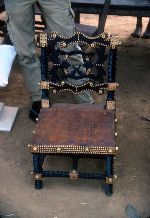
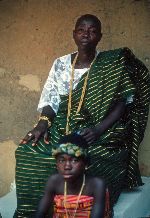
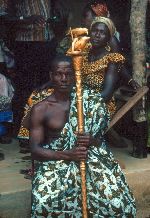
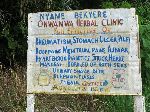 Signs for traditional healers and herbal clinics appear with some regularity in
southern Ghana. This is true in cities, small towns and remote hamlets
(like the one to the left). This sign indicates that the practitioner treats;
"Rheumatism, stomach ulcer, piles, body pain, menstrual pain, asthma,
hypertension, diabetics, stroke, heart, manless, bornless of both sexes, unary,
snake bite, elephantiasis and hernia." It is a short list compared to some
healers, which are fascinating in their comprehensiveness. Someday, someone will do a coffee table book on West Africa
traditional healer signs.
Signs for traditional healers and herbal clinics appear with some regularity in
southern Ghana. This is true in cities, small towns and remote hamlets
(like the one to the left). This sign indicates that the practitioner treats;
"Rheumatism, stomach ulcer, piles, body pain, menstrual pain, asthma,
hypertension, diabetics, stroke, heart, manless, bornless of both sexes, unary,
snake bite, elephantiasis and hernia." It is a short list compared to some
healers, which are fascinating in their comprehensiveness. Someday, someone will do a coffee table book on West Africa
traditional healer signs.
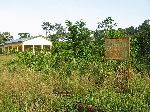
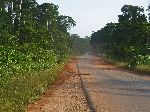
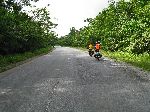
Kuapa Kokoo Ltd Depot, New Edubiase (above left). for what makes Kuapa Kokoo
interesting see KK Generally, around New
Edubiase the countryside is wooded and the road is flat.
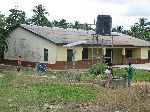 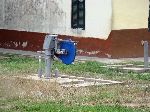 At
first look this water pump looks like a common hand pump, but with a second look
it can be seen that it is attached to additional apparatus; a solar panel,
electric motor, flywheel, value and pipes. Collectively, the system
provides water to a distant location, without constant human labor and without
an ongoing carbon foot print. At
first look this water pump looks like a common hand pump, but with a second look
it can be seen that it is attached to additional apparatus; a solar panel,
electric motor, flywheel, value and pipes. Collectively, the system
provides water to a distant location, without constant human labor and without
an ongoing carbon foot print.
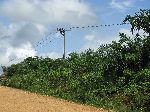
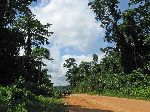 One
more snapshot of progress is a lineman up a power pole string new power
distribution lines. In this section of our route parts of the road looked
like they were One
more snapshot of progress is a lineman up a power pole string new power
distribution lines. In this section of our route parts of the road looked
like they were
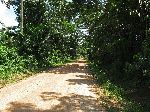 being
readied for paving. As it is now, the roadside is often forested and
traffic is almost non-existent. This will likely change over time as it is
easier to have a higher standard of living in rural areas. The design of
road improvement project -- wider cleared right-of-way and the asphalt road
surface -- both work to heat up the road environment for bicycling. That
is the trade-off for getting rid of the bumps. being
readied for paving. As it is now, the roadside is often forested and
traffic is almost non-existent. This will likely change over time as it is
easier to have a higher standard of living in rural areas. The design of
road improvement project -- wider cleared right-of-way and the asphalt road
surface -- both work to heat up the road environment for bicycling. That
is the trade-off for getting rid of the bumps.
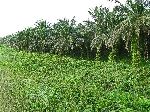
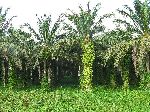
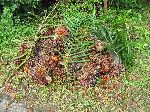
A common crop in the area is oil palm. In conjunction with the oil palm
grove, occasionally there is a stack of oil palm stalks near the road. While
the oil palm groves are sometimes large enough that they might be corporate
farms, the palm oil factors that are visible periodically along the road look
like they are family operations. Presumably the oil palm stalks along the
road are there so that the factories can purchase them and process them into
palm oil.
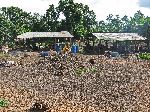 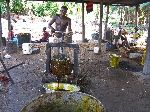 The
production of palm oil is a cottage industry in the area. Because
it was a good time for a break, we stop in at a palm oil factory that was
adjacent to the road. The crew was gracious enough to let us look around
as they worked. The
production of palm oil is a cottage industry in the area. Because
it was a good time for a break, we stop in at a palm oil factory that was
adjacent to the road. The crew was gracious enough to let us look around
as they worked.
The process goes roughly like this: (1, 2, below) The palm
nut fruit is broken off the stalk.
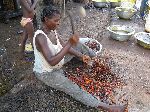
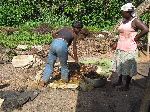
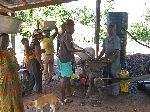
(3, 4, 5) The palm fruit is put through a crushing machine. (6), the crush
palm fruit is heated to help release the oil.
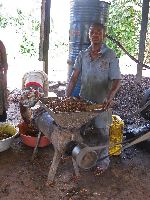
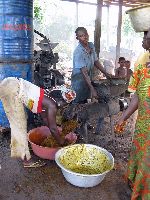
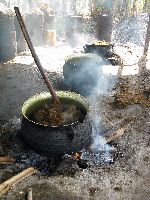
(7, 8, 9) The crushed oil palm fruit is then press to great palm oil. Palm
oil is red because it is very high in beta-carotene.
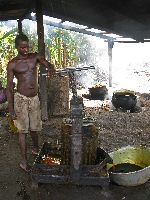
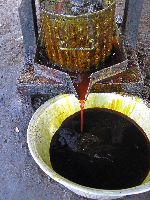
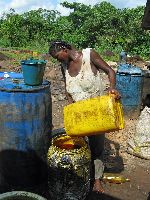
Looking at the division of labor in palm oil factory; some task had one person working on
them, some tasks had two people and some talk had three. And, the mother
to-be got the sit-down task. Everyone was
working very consistently and the division of labor was balanced so that the
palm fruit moved through the factory very evenly. There didn't see to be
any big backlogs or idle time. It was quite efficient. But at a few cedis
per liter it is unlikely that anyone is getting rich at this process -- and
there are a lot of mouths to feed.
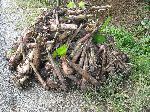 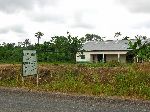 Behind
cocoa and oil palm, bananas may be the next most important agricultural output
in the district. Similar to palm stalks, we saw piles of banana shoots by
the road side. Cocoa is still important as evidenced by another Kuapa Kokoo
depot in Behind
cocoa and oil palm, bananas may be the next most important agricultural output
in the district. Similar to palm stalks, we saw piles of banana shoots by
the road side. Cocoa is still important as evidenced by another Kuapa Kokoo
depot in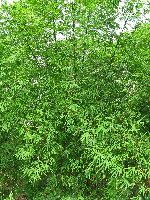
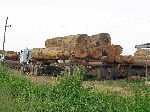 Wasase,
Cape Coast District. Tropical forest hardwood is also part of the economic
mix. They are still pulling big trees out of the forest on a daily basis.
And, if you had any thought of building bamboo bikes you might be interested in
the timber bamboo growing wild in the area. Wasase,
Cape Coast District. Tropical forest hardwood is also part of the economic
mix. They are still pulling big trees out of the forest on a daily basis.
And, if you had any thought of building bamboo bikes you might be interested in
the timber bamboo growing wild in the area.
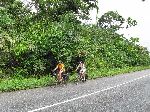
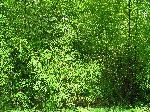
|
Addendum:
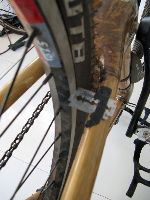
Road fix for a wheel truing jig -- razor
blade and duck tape.
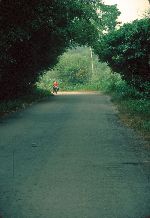
A section of road from 1986
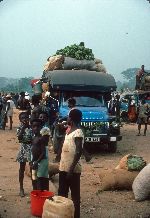
Local transport from 1986 |

















































